Browsing Category
Music
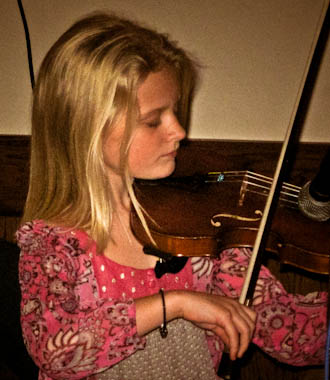
Haley Richardson on fiddle.
The Wren Party tradition is alive and well–and is likely to remain so if the photos of the December 26 traditional Irish event marking the feast day of St. Stephen are any indication. Those musicians were kids! Really. And talented ones too, including All-Ireland qualifiers Keegan Loesel, Haley Richardson, and Emily Safko. Along with the music, there was dancing (and some of the dancers were kids too!) and the annual crazy Wren boy hat parade and competition, which draws more silly hats every year.
We have thosephotos, thanks to Lynette Loesel and John Kelly.
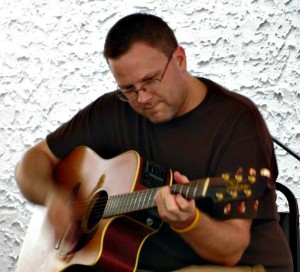
Darin Kelly
Visit Fergie’s Pub on any Saturday afternoon, and the place will be rocking to traditional Irish music, performed by some of the city’s best players. Fiddlers, flutists, accordion players and more have called the pub home for a decade.
This Saturday (January 5), they’ll be positively blowing the doors off the joint as local musicians from all over the place descend upon the standout Sansom Street bar and restaurant to celebrate the 10th anniversary of Fergie’s traditional Irish music session.
Session anchor and guitarist Darin Kelly sees the big blowout as a way to thank owners Fergus Carey and Wajih Abed. Without them, he says, the Fergie’s session wouldn’t have lasted 10 weeks.
“I thought it would be a nice way to celebrate the support that Fergie and Wajih have given to traditional music for 10 years, which is like 80 years in human time,” says Kelly. “Sessions tend to live their functional lives in dog years, as trends come and go. But Fergie and the whole staff have been nothing but supportive and enthusiastic from the jump. I wanted to invite everyone who has been a part of the session since those first notes, and give Fergie our expression of thanks, in the best way we can.”
Gratitude perhaps goes both ways. When Fergie’s opened in 1994, Irish tenor banjo player Jack Crowley anchored the session. Then, for a while, there was a lull. Then, in January of 2003, Kelly—primarily known as a celebrated classical trumpeter—approached Fergie about re-starting the Saturday afternoon live music session. Fergie was enthusiastic from the start, he says. Soon, he and Brendan Callahan—a four-time all-Ireland medalist fiddler now living in Boston—were anchoring one of the jumpingest Irish sessions anywhere, let alone the city.
Like all traditional Irish music sessions, the Fergie’s Saturday afternoon get-together also serves a social purpose for the small core group of regulars who play there, off in a far corner of the room.
“People are there to enjoy each other’s company, swap stories, bust each others’ stones, and generally enjoy a good couple of hours of great music in a rare place without television,” says Kelly. “Fergie’s is pretty small, so naturally our group of players has remained fairly tight-knit. The regular players are people I’ve known and played with for years, and I’ve learned everything I know from these people. And we generally like each other—a rarity. Bottom line, there is better traditional Irish music on a consistent basis coming out of Fergie’s than any other session I know of around here.”
After 10 years, Kelly has piled up a guitar case full of fond memories. He recalls in particular the times when fiddler and dancer Dan Stacey would lace up his hard shoes and take to the floor. “The look on peoples’ faces when he would literally make the room shake was fantastic.”
Sometimes, the vibe was so irresistible, the session blew right through the scheduled 7 p.m. stop. “One night I remember playing pretty much non-stop until 9:45,” Kelly says. “The absolutely sublime moments of music I had with Brendan particularly are memories that I’ll have forever.”
You can find out why the Fergie’s session stirs such tender memories. The 10th anniversary blowout starts at 1 p.m., and lasts ‘til 7—at least, that’s the plan. Fergie’s is at 1214 Sansom Street. There’ll be food and drink specials as an extra incentive. Show up, eat, drink, play (or listen).
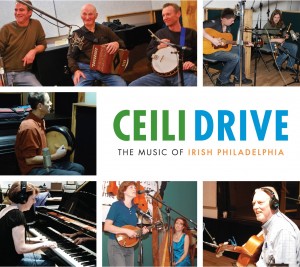
Just about a year ago, we started a CD recording project, gradually bringing together some of Philly’s best Irish music and artists on one great little disc. Roughly half of the tracks are original, recorded at Milkboy Studios in Center City; the rest were donated by many of our nearest and dearest friends. The result is “Ceili Drive: The Music of Irish Philadelphia.
As we’ve noted in the past, “Ceili Drive” features terrific contibutions from three of Philadelphia’s major musical families, the Boyces, the Brennans, and the McGillians; several of our youngest, scary-good musicians, including three rising stars under the age of 13 who’ve already competed twice in the All-Irelands; plus a stellar group of Irish-born musicians who now call Philadelphia home.
We’ve reached a point where we can now show you the cover, which we have finalized. Next up: Duplication, and that begins next week. It should take a couple of weeks more to wrap things up. Sorry we couldn’t be ready for Christmas, but hey … you’re definitely going to want to have a copy of “Ceili Drive” for St. Patrick’s Day, which will be here before you know it. And really, do you need a reason to treat yourself to the best Irish music in Philly?
In addition to the CD cover preview, will whet your appetite with a preview of some of the tracks.
The Milkboy Set
Father Kelly’s, Pigeon on the Gate, Over The Moor To Maggie (trad.); Mountain Road (Michael Gorman)
Kevin and John McGillian (button accordion); Jimmy McGillian (banjo); Tim Hill (uilleann pipes); Caitlin Finley and Chris Brennan Hagy (fiddle); Tom O’Malley (guitar); Dave Hanson (bodhran)
Click here to play: Milkboy Set
Peggy Gordon
Karen Boyce McCollum, John Boyce, and Michael Boyce
Traver’s, Tinker’s Daughter
The Next Generation Kids: Haley Richardson, Alex Weir, Alanna Griffin, Blair Cunningham, and Patrick Glennan (fiddle); Dylan Richardson (guitar); Keegan Loesel (tin whistle); with Dennis Gormley (flute) and Kathy DeAngelo (fiddle)
Stay tuned for ordering info!
eDog” src=”http://irishinphilly.com/wp-content/uploads/2012/12/HeiroftheDog.jpg” alt=”” width=”600″ height=”400″ /> James Keane’s “Heir of the Dog” gets the most play in my house.
Just a warning: I have eclectic (read: quirky) taste. Though I love Irish traditional music, I’m not a strict traditionalist. MY ears don’t catch on fire if someone adds a little jazz percussion or an electric guitar to anything but an Ed Reavy tune (I do hold some things sacred). So, if you have an open-minded Irish music lover (read: oddball) on your list, here are some ideas for their Christmas stocking.
Heir of the Dog
James Keane
Stellar button accordion player James Keane—the Italian Castagnari accordion company created its signature keanebox in his honor–in a recent interview said that he’d dialed back the speed in places on his latest CD, “Heir of the Dog” to a “kitchen-style tempo.” You couldn’t tell by me. I was sure that he went through boxes like ballerinas go through toe shoes—once and done. In Keane’s case, I was sure they just spontaneously combusted. Dang, he’s fast. This is the CD that I’m most likely to carry with my in the car, though listening to the foot-tapping tempo on the road may be more dangerous than texting. Playing with Keane on this CD is Kathleen Boyle of Cherish the Ladies on piano, Eamon O’Leary on guitar and bouzouki, and Tom English on bodhran. You gain great appreciation for them—and for Keane—on the smooth and ethereal “O’Carolan’s Dream.” But what I love most about this CD, my pick for trad CD of the year, is that it immediately transports me to a carefree night at a session, with a beer in front of me, and a feeling that’s there no other place that I’d rather be. (Keane will be performing with nephew, Paraic Keane, and singer/multi-instrumentalist Gabriel Donohue at the Irish Center on Saturday, December 22!) www.cdbaby.com/cd/jameskeane
December Moon
The Henry Girls
I first heard The Henry Girls at my favorite pub in all of Ireland, McGrory’s of Culdaff, in Inishowen, County Donegal, in 2010. My husband and I went in for the session—no Irish music, unless you include Van Morrison, but plenty of contemporary classics—anchored by the McGrory brothers and by the three McLaughlin sisters (they’re the Henry McLaughlins—the nickname is an Inishowen thing). They covered everything from The Band to Richard Thompson and the aforementioned Morrison. When we got home, I looked up The Henry Girls and downloaded their CD of largely Irish traditional tunes, “Dawn.” Their sisterly harmonies and exquisite playing brings a newness to some old favorites, like Early in the Morning, O’Neill’s Lament, Glashedy Boat Song, and some newer tunes, like Thompson’s “Dimming of the Day,” and “Morning Has Broken.” Their virtuosity is on the march in “December Moon,” a total and delightful surprise. Most of the tracks were written by the band, and their Irish influences meld well with the international flavors they’ve absorbed. The first track on the CD, “Sing My Sister Down,” owes its roots to spiritual music, while “December Moon” has a decidedly Cajun feel. They also bring magic to Elvis Costello’s quirky, “Watching the Detectives,” my new favorite song. I’ve read that they’ve performed with one of my other favorite Donegal groups, the Inishowen Gospel Choir. I would kill for a recording of that. The girls have toured the US but have been skirting Philadelphia, largely, I think, because no one has invited them here. Can someone please reach out? www.thehenrygirls.com/wordpress/
Another Side of Town
Seamus Kelleher
I’ve already said I loved this CD. This local boy—Doylestown, via Galway—is making good as a solo act after many years with the Irish Band that-could-fill-a-football stadium, Blackthorn. This is his second solo CD turn, and I’m thrilled that a guy who is my demographic (a Boomer) can get better all the time. (That means there’s hope for me.) Kelleher shines here, not only on instrumentals (his forte), but on the ballads like “Reno’s Winter Sky,” a story song about an encounter with a soldier at a baggage claim in Reno, and the eponymous track, “Another Side of Town,” which I nearly wore out hitting the back button. His remake of his earlier tune, “Four Cups of Coffee,” with Philadelphia R&B singer Charlene Holloway, is risky, earthy, and worth the price of admission. Nice, nice CD. Good on ya, Seamus! http://www.seamusk.com/
Somewhere Along the Road
RUNA
Someone once said that Richard Burton was such an accomplished actor that he could read the phone book and make it sound like a Shakespearean play. I feel similarly about Shannon Lambert-Ryan’s singing. She could warble 10 pages of Smiths and it would sound like the angels singing to me. And when she performs duets with her husband, Dublin-born Fionan de Barra, as she does on the familiar A Stor, A Stor A Chra, we’re talking heavenly host here. The rest of the angels are Cheryl Prasker who brings a little folk and a little jazz in equal measure to percussion and fiddler Tomoko Omuro of Japan whose first few notes on the opening track, The Dreadful End of Marianna for Sorcery, will pierce your heart. I didn’t think anyone could do a better version of Farewell to Tarwathie than Judy Collins, but sweet Judy Blue Eyes, RUNA brings more life and poignancy to this paean to whalers than you do, sorry. Likewise, they take a song, like The Foggy Dew, that we’ve all heard a million times and make it something new, sweet, and wonderful, like the best Christmas present. www.runamusic.com/wordpress/
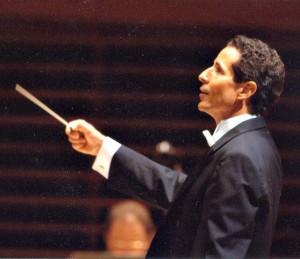
Conductor Ron Matthews
For most orchestras, it’s just about the music. For the Jubilate Deo Chorale and Orchestra, a large non-profit classical ensemble founded in 1991 by two Catholic priests in the Camden diocese, it’s also about faith. And that means a Jubilate Deo Christmas concert—like the group’s Sunday, December 2, Celtic-themed extravaganza at the Kimmel Center—celebrates Christmas as something much more than just a commercial holiday.
“We try to integrate faith into the arts and common culture,” says Ron Matthews, Jubilate Deo conductor and music director. “The spiritual aspect is part of our mission. The orchestra is about 21 years old. (Msgrs.) Louis Marucci and his brother Carl were the founders. Louis was the executive director, and he took over more of the administration and creative planning. Carl was one of the primary directors.”
After 10 years, Carl stepped down. Matthews took over the helm after reading about the job opening in a music union newspaper, and passing a rigorous interview and review process.
Jubilate Deo performs year-round, of course—but Christmas is special. Matthews explains, “In one sense, the season facilitates our mission. We can be who we are because it’s the nature of the season.”
The theme of this year’s Christmas concert, billed as “A Celtic Christmas at the Kimmel,” also ties in with the group’s inherently spiritual mission. In case you’ve somehow missed all of the Black Friday advertising, in many quarters Christmas has nothing to do with the birth of Christ. In Celtic lands, Matthews says, Christmas historically is a more subdued affair, with a far greater emphasis on the Nativity.
This is not the first time Jubilate Deo has integrated Celtic culture into a performance.
““We actually had done a Celtic theme, I think it was two years ago,” Matthews says. “We had some young local Celtic dancers, and we had a penny whistle and Celtic harp. This is a theme we have used periodically, but this performance is the first fully intentional and integrated one.”
Celtic music has been much more popular over the last decade or so, probably beginning with Riverdance, but you also have to give credit to all of the Irish and Scottish bands and performers who took the ball from Riverdance and ran with it. Matthews understands the appeal.
“There’s a grounded energy and authenticity to Celtic music,” says Matthews, who also serves as chair of the Fine and Performing Arts Division and Music Department at Eastern University. “Because of the interest in world music over the last four or five years, with some prominent groups playing Celtic music, there are some great arrangements out there that feature high-energy, Celtic themes. It’s a good bridge to the classical.”
The Kimmel concert features many holiday pieces that come from—or stem from—the Celtic tradition, such as The Wexford Carol, I Wonder As I Wander, A Celtic Silent Night and Celtic Christmas Celebration. The performance also includes many non-Celtic holiday classics, both sacred and secular, such as The Little Drummer Boy, O Come Let Us Adore Him, and It’s The Most Wonderful Time of the Year. There will also be three new pieces, including one by Matthews. If you like Irish-style dance, there will be plenty of that. And if you want to join in on some of the best-known Christmas carols, you’ll have a chance to do that as well.
The Jubilate Chorale will be joined by the Eastern University Ensembles and Church of the Saviour Festival Choir, bringing the number of singers in the overall choir up to 200.
The concert begins at 3 p.m. on Sunday, December 2. You can learn more and get tickets by visiting the Jubilate Deo website.
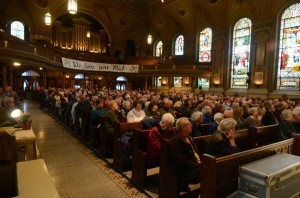
No question about it: the St. Malachy’s crowd loved Mick Moloney.
Maybe the big anniversary had something to do with it, but it was one of the largest crowds ever for this grand tradition, the 25th annual concert benefiting St. Malachy Mission School in North Philadelphia.
Moloney, who spent many years in Philadelphia and is close friends with former pastor Father John McNamee, returns every November with a stellar lineup of musical talent. This year, Moloney’s “friends” included fiddler Dana Lynn; uilleann piper Joey Abarta; singer, guitarist and harmonica player Saul Brody; singer and guitarist Robbie O’Connell; accordion player Billy McComiskey; and two outstanding local fiddlers, Caitlin Finlay and Paraic Keane.
As always, it was all in a good cause: to help support what has been called “a beacon of hope” in a neighborhood that knows more than its fair share of hardship.
We were there from beginning to end, and we captured some photos we think you’ll like. And the pièce de résistance: A video capturing a huge blast of tunes by—fittingly enough—Philly’s prolific Irish tunesmith, Ed Reavy.
wp-content/uploads/2012/11/lilt-300×200.jpg” alt=”Lilt: Keith Carr and Tina Eck” width=”300″ height=”200″ /> Lilt: Keith Carr and Tina Eck
Anyone who has ever traveled to Ireland knows that German tourists love the Emerald Isle as much as Americans do. (I can remember bumping into a tour bus full of Germans on holiday at the Poulnabrone Dolmen, an ancient tomb out in the middle of one of Ireland’s most remote places, the Burren.)
So from the perspective of Tina Eck, who hails from Travemünde, a seaside resort along the border with Denmark, it is not at all unusual that she plays Irish flute, and is part of a popular duo called Lilt. The traditional twosome, which also features Irish bouzouki and tenor banjo player Keith Carr, is scheduled to play Sunday, November 18, as part of the Coatesville Traditional Irish Music Series. (Note to readers: This concert has been canceled.)
Eck, who now lives in Cabin John, Maryland, works as a radio correspondent covering Washington. She moved to the United States to work for Voice of America in September 1992, around the time of Bill Clinton’s election to the presidency. She had traveled to Ireland several times over the years, so she was familiar with Celtic culture. The music, not so much.
Then, one night in the mid-1990s, Eck visited the well-known Connecticut Avenue watering hole Nanny O’Brien’s, where a traditional Irish music session was going full blast.
“Nanny O’Brien’s was a hangout for journalists. You’d sit and drink, and talk politics. It was the first time I had ever heard an Irish session. It was completely mesmerizing.”
Eck resolved to do whatever she needed to do to be a part of that session. She started to teach herself tin whistle, soaking up tunes at the feet of guitarist, session leader and Nanny O’Brien’s owner Brian Gaffney, and others.
“I hadn’t played a musical instrument since I was in 4th grade,” Eck recalls. “I learned a bit of recorder then. But with Irish music, it was unbelievable that you could just sit behind a piper, and pick it all up by ear. You didn’t need to read music. I still can read music a little, but Irish music is truly accessible. You learn the music from your friends. That’s part of the appeal … the whole social thing, you know?”
Eck never did have formal lessons, though she did pick up bits and pieces from other whistle players. At that point, she was content to just keep tootling along on her whistle. But it wasn’t all that long before some of the other players were suggesting that she just might like the Irish wooden flute.
“Everybody said I should, Eck says. “I didn’t want to as I was really happy with the whistle. Then, one night, one of the flute players brought an old Casey Burns flute to the session—it was in a long green woolen sock—and he said, ‘Hold onto it as long as you like, and learn this.'”
It wasn’t long before Eck found herself banging out tunes on the flute. She says she was highly influenced by one of the best Irish flute players on the planet. “I complete idolized Seamus Egan (of the band Solas). To be able to play like him would be so great. That really motivated me.”
As with whistle, Eck learned flute in dribs and drabs from other players. She recalls in particular an informal—really informal—lesson from the great Galway-born Mike Rafferty.
“I asked him, ‘How you play a roll?” and he said ‘You just wiggle your fingers.” End of lesson.
Eck followed up with frequent trips to Ireland to pick the brains of the best at the Willie Clancy, Frankie Kennedy and Sligo summer schools. All of that learning was having the desired effect. She was getting good, and becoming known.
Eck’s musical partnership with Keith Carr—which would lead to the formation of Lilt—began in 2009, and quite by accident. Eck had booked a funeral, lining up guitarist Zan McLeod to accompany her, but McLeod dropped out at the last minute. Eck knew Carr from the Nanny O’Brien session, so she asked him to accompany her, and she quickly discovered that she and this talented bouzouki player were a good musical fit for each other.
“I think it was in the fall of 2009 that we started playing together more,” Eck recalls. “And in 2010, we went into the studio to record a few things, just for fun. I remember, it was in the middle of a blizzard. We sat down for a few hours, and we played what we liked to play.”
Eck didn’t everything on the recording, but she says Capital-area Irish music aficionados had a different opinion. “I think we made 500 copies of that first demo. People loved it. They were just ripping the CDs from our fingers.”
At that point, it became clear that Eck and Carr should formalize their partnership. Then came the question of a name, but Eck had actually thought about that even before a band of any kind became a possibility.
“My husband actually came up with the name ‘Lilt,” says Eck. “He said, if you ever have a group, why don’t you call yourselves ‘Lilt’?” That name stuck with Keith and me, and we began to play together more regularly.”
As to the question of what to play, the answer was obvious: dance music. As she had progressed, Eck had been invited to play in ceili bands. She remembers it being a challenge: “I could barely keep up.” But soon she settled in, and discovered a whole new reason to enjoy playing Irish music, and in particular, a preferred style of play for the then-new duo Lilt.
“I love playing for dances. The dancers fill in all the blanks. I think a hornpipe can sound a little dorky all by itself, but as soon as you have shoes pounding out the rhythm, that’s when the music has lift and energy. So Lilt now is the quintessential dance band. We still do play for dances, but sometimes in performances, we also have step dancers and sean nos (old style) dancers. Not in every tune, not in every piece, but when the dancers get going, it’s not only a crowd pleaser. I get goose bumps.”
You can get your own goose bumps by snagging a ticket for the Coatesville concert.






